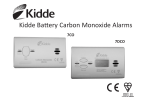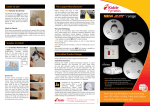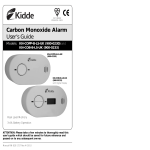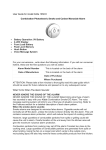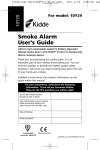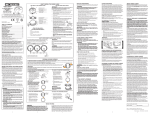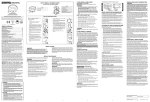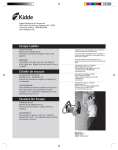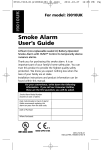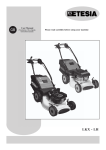Download product manual
Transcript
Kidde Safety Europe Limited Battery Operated COMBINATION SMOKE & CARBON MONOXIDE ALARM With 2-LED Display and Peak Level Memory User’s Guide ALARM OFF For questions concerning your Smoke and Carbon Monoxide Alarm, please call 0800 917 0722 (Mon-Frid 9am-5pm) Installation instructions MUST be adhered to. OPERATE ON PUSH & HOLD TO TEST WEEKLY T W IS T VE TO FRESH AIR MO Assembly Number 900-0122-UK KIDDE SMOKE AND CARBON MONOXIDE ALARM For your convenience, write down the following information. If you call our consumer hotline, these are the first questions you will be asked: Alarm Model Number (located on back of alarm): Date of Manufacture (located on the back of the alarm): Date of Purchase: Where Purchased: TESTED BY THE LOSS PREVENTION COUNCIL/B.R.E. BOARD FOR ALARM POINTS TO BS7860-1996-Carbon Monxide BS5446-2000-Smoke Alarm Alarm Assembly Number (located on the back of the alarm) Manual P/N 810-1808-Rev. A Table of Contents Introduction ..............................................................................Page 1 Product View ........................................................................Pages 2-3 Features ..................................................................................Pages 4-7 Operating/Installation Instructions Step 1 Installing Batteries ............................................................Page 8 Step 2 Installation Instructions: A. Recommended Installation Locations ........................Pages 9-10 B. Where Not to Install ..................................................Page 11-12 C. How to Install..................................................................Page 12 D. Tamper Resist Feature ....................................................Page 13 Step 3 Testing the Alarm ..........................................................Page 14 Step 4 Peak Level Memory........................................................Page 15 What to do if the Alarm Sounds Smoke Alarm........................................................................Pages 15-16 Carbon Monoxide Alarm ....................................................Pages 17-18 Battery Replacement ......................................................Pages 18-19 General Alarm Maintenance ........................................Pages 19-20 Carbon Monoxide Safety Information General CO Information............................................................Page 21 Possible Sources ..........................................................................Page 21 CO Safety Tips............................................................................Page 22 Symptoms of CO Poisoning ................................................Page 22-23 Fire Safety Information Escape Plan..................................................................................Page 23 Fire Prevention ............................................................................Page 24 Warranty and Service Information ............................Pages 25-27 Product Registration ................................................................Page 28 Details on CO alarm installation as stated in Annex B of BS7860-1996 ................................................................................Page 29 Introduction Thank you for purchasing the Kidde Combination Smoke and Carbon Monoxide Alarm model 900-0122-UK. This alarm has a five-year limited warranty. Please take a few minutes to thoroughly read this user’s guide, and save for future reference. Teach children how to respond to the alarms, and that they should never play with the unit. Your Kidde Smoke/CO Alarm was designed to detect both smoke and carbon monoxide from any source of combustion in a residential environment. It is not designed for use in a caravan or boat. If you have any questions about the operation or installation of your alarm, please call 0800 917 0722 (Monday to Friday 9am - 5pm). The guide on page 24 will help you determine the correct location of safety products that will help keep your home a safer place. 1 Product View FRONT Red LED Light ALARM OFF Test/Reset Button OPERATE ON PUSH & HOLD TO TEST WEEKLY T W IS T VE TO FRESH AIR MO KIDDE SMOKE AND CARBON MONOXIDE ALARM Alarm Sounder 2 Green LED Light Product View BACK WARNING: BATTERIES MISSING INSTALL THIRD 2 AA Battery INSTALL SECOND 1 AA Battery INSTALL FIRST WARNING: BATTERIES HAVE BEEN REMOVED AA Battery 3 INSTALL + LAST INSTALL + SECOND INSTALL FIRST + 3 2 1 Battery Chamber Battery Placement 3 Features • Permanent independent smoke and carbon monoxide sensors. • Smoke alarm takes precedence when both fire and carbon monoxide are present. • Alarm/Voice message warning system that alerts you of the following conditions in the manner described below, thus eliminating any confusion over which alarm is sounding: FIRE: The alarm/voice pattern is three long alarm beeps followed by the verbal warning message “FIRE! FIRE!”. This pattern is repeated until the smoke is eliminated. The red LED light will flash while in alarm/voice mode. CARBON MONOXIDE: The alarm/voice pattern is four short alarm beeps followed by the verbal warning message “WARNING! CARBON MONOXIDE!” After four minutes the alarm/voice pattern will sound once every minute until the unit is reset, or the CO eliminated. The red Light Emitting Diode (LED) light will flash while in alarm/voice mode. LOW BATTERY: When the batteries are low and need replacing the red LED light will flash and the unit will “chirp” one time, followed by the warning message “LOW BATTERY.” This cycle will occur once every minute for the first hour. After the first hour the red LED light will continue to flash every minute accompanied by the “chirp” only sound. The voice message “LOW BATTERY” will sound once every fifteen minutes during the “chirp” only cycle. This will continue for at least seven days. 4 Features • One “chirp” every 30 seconds is an indication that the alarm is malfunctioning. If this occurs call the Consumer Hotline at 0800 917 0722 (Monday to Friday 9am - 5pm). • Loud 85 decibel alarm. • Oversized test button for easy activation. • Test button performs the following functions: Tests the units electronics and verifies proper unit operation Resets the unit during CO alarm Peak Level Memory (See page 15). • Mounting bracket designed for easy orientation of unit. • Green and red LED lights that indicate normal operation and alarm status. Green Light: The green Light Emitting Diode(LED) flashes every 30 seconds to indicate the unit is operating properly. The green light also flashes before a CO reading is taken and when any button is pressed. Red Light: When a dangerous level of smoke or carbon monoxide is detected the red Light Emitting Diode (LED) will flash and the corresponding alarm pattern (depending on the source) will sound. If the unit malfunctions, the red LED light will flash and the unit will chirp every 30 seconds indicating a system problem. • Powered by three (3) AA batteries. • Battery lockout system that prohibits installation without using three batteries. • Tamper Resist Feature that deters children and others from removing the alarm. 5 Smoke Alarm Features Smoke Alarm The smoke alarm monitors the air for products of combustion that are produced when something is burning or smouldering. When smoke particles in the smoke sensor reach a specified concentration, the alarm/voice message warning system will sound, and be accompanied by the flashing red LED light. The smoke alarm takes precedence when both smoke and carbon monoxide are present. This unit has a smoke sensor that uses the ionisation technology. Ionisation units are the fastest at responding to fast flaming fires that give off little smoke. Photoelectric smoke alarms are the fastest at responding to slow smouldering, smoky fires. Kidde Safety recommends for maximum protection that both ionisation and photoelectric smoke alarms should be installed. Home fires can develop in different ways and are often unpredictable. Neither type of alarm is always best, and a given alarm may not always provide warning of a fire. CAUTION: Smoke must reach the sensor to be detected. Smoke alarms may not sense fires starting in chimneys, walls, on roofs, on the other side of a closed door, or on a different floor. The alarm may be unable to wake a sound sleeper, or someone impaired by alcohol or drugs. 6 Carbon Monoxide Alarm Features Carbon Monoxide (CO) Alarm The carbon monoxide (CO) alarm monitors the air for the presence of CO. It will alarm when there are high levels of CO present, and when there are low levels of CO present over a longer period of time. When a CO condition matches either of these situations, the alarm/voice message warning system will sound, and be accompanied by the flashing red LED light. The carbon monoxide sensor uses an electrochemical technology. CAUTION: This alarm will only indicate the presence of carbon monoxide gas at the sensor. Carbon monoxide gas may be present in other areas. Individuals with medical problems may consider using warning devices which provide audible and visual signals for carbon monoxide concentrations under 30 ppm. 7 Operating/Installation Instructions Step 1 Installing Batteries: Batteries were not installed at the factory and must be installed for the unit to operate! Install the three (3) AA batteries in the back of the Smoke/CO Alarm. • The mounting plate must be removed from the back of the unit to install batteries. To remove, hold the mounting plate and twist counterclockwise (left). Batteries Must Be Installed in Order Shown Below: 2. 1. Install Last Install Second Install First AA Battery 3 INSTALL THIRD 2 AA Battery INSTALL SECOND WARNING: BATTERIES HAVE BEEN REMOVED 3. 1 AA Battery 3. 2. INSTALL FIRST WARNING: BATTERIES MISSING INSTALL + LAST INSTALL + SECOND INSTALL FIRST + 3 2 1 1. • The battery polarity markings on the bottom of the battery compartment must be adhered to. • Batteries must be installed in the sequence shown. If batteries seem difficult to install, they’re not being installed in the proper sequence. • Smoke/CO Alarm will not engage to bracket unless all three batteries are installed. Removal of any or all batteries will render the Smoke/CO Alarm inoperative! • After the batteries are correctly installed the unit will beep once and the red LED light will flash. After 20-30 seconds the green LED light will flash indicating the unit is now operational. CAUTION: Your Smoke/CO Alarm is sealed and the cover is NOT removable! 8 Operating/Installation Instructions Step 2 Installation Instructions: IMPORTANT: THIS ALARM MUST BE MOUNTED ON A CEILING OR WALL. WHERE POSSIBLE, THE ALARM SHOULD BE INSTALLED ON THE CEILING IN PREFERENCE TO A WALL. IT IS NOT DESIGNATED FOR USE AS A TABLETOP DEVICE! DO NOT INSTALL AT SKIRTING BOARD LEVEL. TO MEET BRE (Building Research Establishment) GUIDELINES, IT IS ESSENTIAL THAT THE INSTALLATION PROCEDURE IS FOLLOWED ACCURATELY. A. Recommended Installation Locations: Kidde Safety recommends the installation of a Smoke/CO Alarm in the following locations. For maximum protection we suggest an alarm be installed on each level of a multilevel home, including every bedroom, hallways, attics and cellars. Put alarms at both ends of bedroom, hallway or large room if hallway or room is more than 30ft. (9.1m) long. If you have only one alarm, ensure it is placed in the hallway outside of the main sleeping area, or in the main bedroom. Verify the alarm can be heard in all sleeping areas. Locate an alarm in every room where someone sleeps with the door closed. The closed door may prevent the alarm from waking the sleeper. Smoke, heat and combustion products rise to the ceiling and spread horizontally. Mounting the alarm on the ceiling in the centre of the room places it closest to all points in the room. Ceiling mounting is preferred in ordinary residential construction. When mounting an alarm on the ceiling, locate it at a minimum of 4” (10cm) from the side wall (see Diagram A). If installing the alarm on the wall, use an inside wall with the top edge of the alarm at a minimum of 4” (10cm) and a maximum of 12” (30.5cm) below the ceiling (see Diagram A). • Please refer to page 29 for information on CO installation in reference to BS7860-1996. 9 Operating/Installation Instructions Mobile Homes: Mobile homes built within the last five to seven years are designed to be energy efficient. Install Smoke/CO alarms as recommended above. (Refer to Recommended Installation Instructions and Diagram A) In mobile homes that are not well insulated, extreme heat or cold can be transferred from the outside to the inside through poorly insulated walls and roof. This may cause a thermal barrier, which can prevent smoke from reaching an alarm mounted on the ceiling. In such mobile homes install your Smoke/CO Alarm on an inside wall with the top edge of the alarm at a minimum of 4 inches (10cm) and a maximum of 12 inches (30.5cm) below the ceiling. (See Diagram A) If you are not sure about the insulation in your mobile home, or if you notice that the outer walls and ceiling are either hot or cold, install your alarm on an inside wall ONLY! DIAGRAM A 10 Operating/Installation Instructions ! ▲ WARNING - This product is intended for use in ordinary indoor locations of family living units. It is not designed to measure compliance with HSE Guidelines for commercial and industrial exposure. B. Where Not to Install: Do not install in garages, kitchens, boiler rooms or bathrooms! INSTALL AT LEAST 1.85 METRES AWAY FROM ANY FUEL BURNING APPLIANCE. Do not install within 3 ft (.9m) of the following: The door to a kitchen, or a bathroom that contains a bath or shower, forced air vents used for heating or cooling, ceiling or whole house ventilating fans, or other high air flow areas. Avoid excessively dusty, dirty or greasy areas. Dust, grease or household chemicals can contaminate the alarm’s sensors, causing it to not operate properly. Place the alarm where curtains or other objects will not block the sensor. Smoke and CO must be able to reach the sensors to accurately detect these conditions. Do not install in peaks of vaulted ceilings, “A” frame ceilings or gabled roofs. Keep out of damp and humid areas. Install at least 0.3m away from fluorescent lights, electronic noise may cause nuisance alarms. Do not place in direct sunlight and keep out of insect infested areas. Extreme temperatures will effect the sensitivity of the Smoke/CO Alarm. Do not install in areas where the temperature is colder than 40 degrees Fahrenheit (4.4 Celsius) or hotter than 100 degrees Fahrenheit (37.8 Celsius). Place away from doors and windows that open to the outside. Do not install in areas where the relative humidity (RH) is above 85%. 11 Operating/Installation Instructions C. How to Install: Remove mounting plate from the back of the unit by holding the rim of the mounting plate and twisting counterclockwise (left). Seven (7) years after initial power up, this unit will “chirp” every 30 seconds to indicate that it is time to replace the alarm. After seven (7) years, the device may no longer detect carbon monoxide accurately and should be replaced immediately. On the product label, which is located on the back of the alarm, there is a location that has ‘Replace by’ printed on it. Write the replace-by date on the label. The date written on the label should be seven (7) years after the date the unit is initially powered up. Hold the mounting plate against the selected installation location (wall or ceiling) and mark the centre of the holes with a pencil. To ensure aesthetic alignment of the alarm with the hallway, or wall, the “A” line on the mounting plate must be parallel with the hallway when ceiling mounting, or horizontal when wall mounting. Drill a hole through the pencil marks and use the enclosed screws and anchors to secure (use 5mm drill bit for anchor holes). Align the Smoke/CO Alarm with the mounting plate and rotate clockwise (right) until the unit is aligned. Two labels are included with your alarm. They have important information on what to do in case of an alarm. Add the phone number of your emergency service provider in the space provided. Place one label next to the alarm atfer it is mounted, and one label near a fresh air source When wall mounting, the “A” line should such as a door or window. be horizontal. A Alignment Marks FIGURE 1 Remove 12 A Install FIGURE 1 When mounting in a hallway, the “A” line should be parallel with the hallway. Operating/Installation Instructions D. Tamper Resist Feature: To make your smoke alarm somewhat tamper resistant, a tamper resist feature has been provided. Activate the tamper resist feature by breaking off the four posts in the square holes in the trim ring (see Figure A). When the posts are broken off, the tamper resist tab on the base is allowed to engage the mounting bracket. Rotate the alarm onto the mounting bracket until you hear the tamper resist tab snap into place, locking the alarm on the mounting bracket. Using the tamper resist feature will deter children and others from removing the alarm from bracket. NOTE: To remove the alarm when the tamper resist tab is engaged, press down on the tamper resist tab, and rotate the alarm off the bracket (see Figure B).Screw and anchor accessories are supplied. FIGURE A A A Posts FIGURE B 13 Operating/Installation Instructions Step 3 Testing the Alarm The test button has three purposes. It tests the unit’s electronics, resets the alarm and activates the peak level memory (See page 15). CAUTION: Due to the loudness (85 decibels) of the alarm, always stand an arms length away from the unit when testing. • To test: Press the test/reset button for five seconds and a series of beeps will sound, followed by the message “Fire! Fire!”, then another two series of beeps and the message “Warning! Carbon Monoxide”, followed by 4 additional short beeps. • Reset: If the smoke/CO alarm is sounding a CO alarm, pressing the test/reset button will silence the alarm. If the CO condition that caused the alert continues, the alarm will reactivate. Reactivation times depend on the amount of CO present. See page 18. • Peak Level Memory: If 8 chirps are made when pushing the test/reset button, the unit has detected a CO level of 100 PPM or greater. The unit needs to be tested weekly! If at anytime it does not perform as described, verify the three batteries are installed correctly and that they don’t need replacing. Clean dust and other buildup off the unit. If it still doesn’t operate properly call the Consumer Hotline 0800 917 0722 (Monday to Friday 9am - 5pm) 14 Operating/Installation Instructions and What To Do If The Alarm Sounds Step 4 Peak Level Memory If the CO sensor has detected a CO level of 100 PPM or higher since last reset, it will be recorded by the Peak Level Memory function. To access the Peak Level Memory press the test/reset button. If a reading of 100 PPM or higher has been recorded the unit will chirp 8 times. If you’ve been away from home this feature allows you to check if there was a CO reading of 100, or higher, during your absence. Pushing the test/reset button resets the memory. It’s also reset when batteries are removed. What To Do If The Alarm Sounds NEVER IGNORE THE SOUND OF THE ALARM! Determining what type of alarm has sounded is easy with your Kidde Combination Smoke/CO Alarm. The voice message warning system will inform you of the type of situation occurring. Refer to the Features section on page 4 for a detailed description of each alarm pattern. When the smoke alarm sounds: Smoke alarms are designed to minimise false alarms. Cigarette smoke will not normally set off the alarm, unless the smoke is blown directly into the alarm. Combustion particles from cooking may set off the alarm if located too close to the cooking area. Large quantities of combustible particles are generated from spills or when grilling. Using the fan on a cooker hood which vents to the outside (non recirculating type) will also help remove these combustible products from the kitchen. 15 What To Do If The Alarm Sounds If the alarm sounds, check for fires first. If a fire is discovered follow these steps. Become thoroughly familiar with these items, and review with all family members! • Leave immediately using one of your planned escape routes (see page 23). Every second counts, don’t stop to get dressed or pick up valuables. • Before opening inside doors look for smoke seeping in around the edges, and feel with the back of your hand. If the door is hot use your second exit. If you feel it’s safe, open the door very slowly and be prepared to close immediately if smoke and heat rush in. • If the escape route requires you to go through smoke, crawl low under the smoke where the air is clearer. • Go to your predetermined meeting place. When two people have arrived one should leave to call 999 from a neighbour’s home, and the other should stay to perform a head count. • Do not go back in to the house under any circumstance until fire officials give the go ahead. 16 What To Do If The Alarm Sounds When the carbon monoxide alarm sounds: ! ▲ WARNING: Actuation of your CO Alarm indicates the presence of Carbon Monoxide (CO) which can KILL YOU. If alarm signal sounds: 1) Operate the test/reset button; 2) If the property has gas call Transco PHONE NUMBER 0800 111 999 3) Immediately move to fresh air - outdoors or by an open door/window. Do a head count to check that all persons are accounted for. Do not go back into the premises nor move away from the open door/window until the emergency services responders have arrived, the premises have been aired out, and your alarm remains in its normal condition. 4) After following steps 1-3, if your alarm reactivates within a 24 hour period, repeat steps 1-3 and call a qualified gas installer ADD PHONE NUMBER to investigate for sources of CO from fuel burning equipment and appliances, and to inspect for proper operation of this equipment. If problems are identified during this inspection have the equipment serviced immediately. Note any combustion equipment not inspected by the gas installer and consult the manufacturer’s instructions, or contact the manufacturer’s directly, for more information about CO safety and this equipment. Make sure that motor vehicles are not, and have not been, operating in an attached garage or adjacent to the residence. 17 What To Do If The Alarm Sounds Never restart the source of a CO problem until it has been fixed. NEVER IGNORE THE ALARM! The CO sensor meets the alarm response time requirements of BS7860. Standard alarm times are as follows: At 45 PPM, the unit must not alarm before 60 minutes. At 150 PPM, the unit must alarm within 10-30 minutes. At 350 PPM, the unit must alarm within 6 minutes. This carbon monoxide alarm is designed to detect carbon monoxide gas from ANY source of combustion. It is NOT designed to detect any other gas. British gas and some gas engineers will perform CO inspections, some may charge for this service. It’s advisable to inquire about any applicable fees prior to having the service performed. Kidde Safety will not pay for, or reimburse, the owner or user of this product, for any repair or dispatch calls related to the alarm sounding. Battery Replacement If any form of battery failure is detected the red LED light will flash and the unit will “chirp” one time, followed by the warning message “LOW BATTERY.” This cycle will occur once every minute for the first hour. After the first hour, the red LED light will continue flashing accompanied by the chirp only sound every 60 seconds. 18 Battery Replacement The voice message “LOW BATTERY” will sound once every fifteen minutes during the chirp only cycle, and will continue for at least seven days. If the red LED light flashes along with a chirp every 30 seconds, and is not followed by the voice message “LOW BATTERY” as described above, your unit has malfunctioned. Call our free Consumer Hotline 0800 917 0722 (Monday to Friday 9am - 5pm) for instructions on how to return the unit. Refer to Step 1 on page 8 for information on installing the batteries. Replace batteries with one of the following approved brands of Alkaline batteries: Duracell MN1500, MX1500 or Energizer E91. WARNING! Use only the batteries specified. Use of different batteries may have a detrimental effect on the Smoke/CO alarm. A good safety measure is to replace the batteries twice a year, at the same time you change your clocks for daylight saving time. General Maintenance To keep your Smoke/CO Alarm in good working order, please follow these simple steps: • Verify unit alarm, lights and battery operation by pushing the test/reset button once a week. • Remove the unit from mounting bracket and vacuum the alarm cover and vents with a soft brush attachment once a month to remove dust and dirt. REINSTALL IMMEDIATELY AFTER CLEANING AND THEN TEST USING THE TEST/RESET BUTTON! IF TAMPER RESIST FEATURE HAS BEEN ACTIVATED, REFER TO TAMPER RESIST FEATURE DESCRIPTION ON PAGE 13 FOR REMOVAL INSTRUCTIONS. 19 General Maintenance • Never use detergents or other solvents to clean the unit. • Avoid spraying air fresheners, hairspray, or other aerosols near the Smoke/CO Alarm. Do not paint the unit. Paint will seal the vents and interfere with the sensor’s ability to detect smoke and CO. Never attempt to disassemble the unit or clean inside. This action will void your warranty. Move the Smoke/CO Alarm and place in another location prior to performing any of the following: • Staining or stripping wood floors or furniture • Painting • Wallpapering • Using adhesives Storing the unit in a plastic bag during any of the above projects will protect the sensors from damage. Do not place near a nappy bucket. WARNING: Reinstall the Smoke/CO Alarm as soon as possible to assure continuous protection. When household cleaning supplies or similar contaminates are used, the area must be well ventilated. The following substances can effect the CO sensor and may cause false readings and damage to the sensor: Methane, propane, iso-butane, iso-propanol, ethyl acetate, hydrogen sulphide, sulphide dioxides, alcohol based products, paints, thinner, solvents, adhesives, hairspray, aftershave, perfume and some cleaning agents. 20 Carbon Monoxide Safety Information General CO Information Carbon monoxide (CO) is a colourless, odourless and tasteless poison gas that can be fatal when inhaled. CO inhibits the blood’s capacity to carry oxygen. Possible Sources CO can be produced when burning any fossil fuel: petrol, propane, natural gas, oil and wood. It can be produced by any fuel-burning appliance that is malfunctioning, improperly installed, or not ventilated correctly. Possible sources include boilers, gas stoves, gas clothes dryers, water heaters, portable gas/paraffin heaters, fireplaces, wood-burning stoves and certain swimming pool heaters. Blocked chimneys or flues, back drafting and changes in air pressure, corroded or disconnected vent pipes, and a loose or cracked boiler heat exchanger can also cause CO. Vehicles and other combustion engines running in an attached garage and using a charcoal/gas grill in an enclosed area are all possible sources of CO. The following conditions can result in transient CO situations: Excessive spillage or reverse venting of fuel-burning appliances caused by outdoor ambient conditions such as: Wind direction and/or velocity, including high gusts of wind, heavy air in the vent pipes (cold/humid air with extended periods between cycles), negative pressure differential resulting from the use of exhaust fans, simultaneous operation of several fuel-burning appliances competing for limited internal air, vent pipe connections vibrating loose from clothes dryers, boilers, or water heaters, obstructions in, or unconventional, vent pipe designs which can amplify the above situations, extended operation of unvented fuel-burning devices (gas hob, oven, fireplace, etc.), temperature inversions which can trap exhaust gasses near the ground, car idling in an open or closed attached garage or near a home. 21 Carbon Monoxide Safety Information CO Safety Tips Every year have the heating system, vents, chimney and flue inspected and cleaned by a qualified technician. Gas appliances can only be serviced by a Corgi engineer. Always install appliances according to manufacturer’s instructions and adhere to local building codes. Most appliances should be installed by professionals and inspected after installation. Regularly examine vents and chimneys for improper connections, visible rust, or stains, and check for cracks in boiler heat exchangers. Verify the colour of flame on pilot lights and burners is blue. A yellow or orange flame is a sign that the fuel is not burning completely. Teach all household members what the alarm sounds like and how to respond. Symptoms of CO Poisoning Initial carbon monoxide poisoning symptoms are similar to the flu with no fever and can include dizziness, severe headaches, nausea, vomiting and disorientation. Everyone is susceptible but experts agree that unborn babies, pregnant women, senior citizens and people with heart or respiratory problems are especially vulnerable. If symptoms of carbon monoxide poisoning are experienced seek medical attention immediately. CO poisoning can be determined by a carboxyhemoglobin test. The following symptoms are related to CARBON MONOXIDE POISONING and should be discussed with ALL members of the household: 1. Mild Exposure: Slight headache, nausea, vomiting fatigue (often described as “Flu-like” symptoms). 22 Carbon Monoxide Safety Information 2. Medium Exposure: Severe throbbing drowsiness, confusion, fast heart rate. headache, 3. Extreme Exposure: Unconsciousness, convulsions, cardiorespiratory failure, death. The above levels of exposure relate to healthy adults. Levels differ for those at high risk. Exposure to high levels of carbon monoxide can be fatal or cause permanent damage and disabilities. Many cases of reported carbon monoxide poisoning indicate that while victims are aware they are not well, they become so disoriented they are unable to save themselves by either exiting the building, or calling for assistance. Also, young children and household pets may be the first effected. Familiarisation with the effects of each level is important. Fire Safety Information Escape Plan Prepare and practice a home escape plan twice a year. Know two ways out of every room (door & window) and identify a meeting place outside the home where everyone will gather once they have exited the residence. When two people have reached the meeting place, one should leave to call 999* while the second person stays to account for additional family members. Establish a rule that once you’re out, you never go back in to the house under any circumstance! *NOTE IF THE PROPERTY HAS GAS: For Carbon Monoxide incidences/emergencies call Transco on 0800 111 999. 23 Fire Safety Information (cont.) Fire Prevention Never smoke in bed, or leave cooking food unattended. Teach children never to play with matches or lighters! Train everyone in the home to recognise the alarm pattern, voice message warning and to leave the home using their escape plan when it’s heard. Know how to do Stop, Drop and Roll if clothes catch on fire, and how to crawl low under smoke. Install and maintain fire extinguishers on every level of the home and in the kitchen, cellar and garage. Know how to use a fire extinguisher prior to an emergency. Second level and higher occupied rooms with windows, should have an escape ladder. BEDROOM GARAGE KITCHEN HALL MASTER BEDROOM FAMILY ROOM CELLAR WORKSHOP FIRE EXTINGUISHERS SMOKE ALARMS CARBON MONOXIDE ALARMS SMOKE/CO ALARM Further information on fire protection & CO poisoning can be found on our website. 24 www.kiddesafetyeurope.co.uk Warranty and Service Information Warranty FIVE YEAR FACTORY WARRANTY Kidde Safety Europe guarantees to you as a purchaser that the enclosed alarm will be free of defects in material, workmanship or design under normal use and service for a period of 5 years, from the date of purchase excluding any loose battery supplied. The guarantee is not assignable. Our liability to you under this guarantee is limited to repairing or replacing any part which we find to be defective in material, workmanship or design, free of charge to the customer, who is situated within the UK, upon sending the alarm with proof of date of purchase, postage prepaid to: Kidde Safety Europe Limited, Mathisen Way, Colnbrook, SL3 0HB, UK. The terms of this guarantee will not apply in the following circumstances: If alarm has been damaged, modified, neglected, dismantled, contaminated, abused or altered after the date of purchase; or if it fails to operate due to incorrect selection, siting, installation, maintenance, inadequate AC or DC electrical power; or damage caused by failure to abide by the instructions supplied. The liability of Kidde, arising from the sale of this alarm or 25 Warranty and Service Information (cont) under the terms of this guarantee shall not in any case exceed the cost of the replacement of the alarm, in no case, shall be liable for consequential loss or damage resulting from the failure of the alarm or for the breach of this or any other guarantee, express or implied. This guarantee does not affect your statutory rights. Kidde makes no guarantee, express or implied, written or oral, including that of satisfactory quality or fitness for any particular purpose, with respect to the battery. THIS ALARM IS NOT INTENDED TO ALERT HEARING IMPAIRED INDIVIDUALS. 26 Service Information During the specified warranty period Kidde Safety Europe will repair or replace, at its discretion any defective Kidde Combination Smoke & CO Alarms that are returned in a postage paid package to the following address: Kidde Safety Europe Limited, Mathisen Way, Colnbrook, SL3 0HB, UK. Please include your name, address and phone number along with a brief description of what is wrong with the unit. For further assistance please call our free Consumer Hotline on 0800 917 0722 (Monday to Friday 9am - 5pm). Damage from neglect, abuse or failure to adhere to any of the enclosed instructions will result in termination of the warranty, and the unit will not be replaced or repaired. 27 Product Registration This manual and the products described herein are copyrighted, with all rights reserved. Under these copyright laws, no part of this manual may be copied for use without the written consent of Kidde Safety Europe. If you require further information please contact us on 0800 917 0722 (Monday to Friday 9am - 5pm) or write to us at: Kidde Safety Europe Limited, Mathisen Way, Colnbrook, SL3 0HB, UK.Our internet address is www.kiddesafetyeurope.co.uk 28 DETAILS ON CO ALARM INSTALLATION AS STATED IN ANNEX B OF BS7860-1996 IN WHICH ROOM TO PUT THE ALARM: Ideally, you should have an alarm in or near every room that contains a fuel burning appliance. However, if you have more than one appliance, but only one alarm, you should take the following into consideration when deciding where best to put the alarm. If there is an appliance in the room where you sleep, you should put the alarm in that room. If there is an appliance in a room that you use a lot eg. sitting room, you should put it in that room. If you live in a bedsit, put the alarm as far away from the cooking appliances as possible, but near to the place where you sleep. If the appliance is in a room not normally used (eg. boiler room) put the alarm just outside the room so that you will be able to hear the alarm more easily. 29 Mathisen Way, Colnbrook, Slough, Berkshire SL3 0HB Telephone 01753 685148 Fax 01753 685096 www.kiddesafetyeurope.co.uk FREEPHONE 0800 917 0722 (Mon-Frid 9am - 5pm) Custom Assembled in China with U.S. and Foreign Components. Patents pending


































